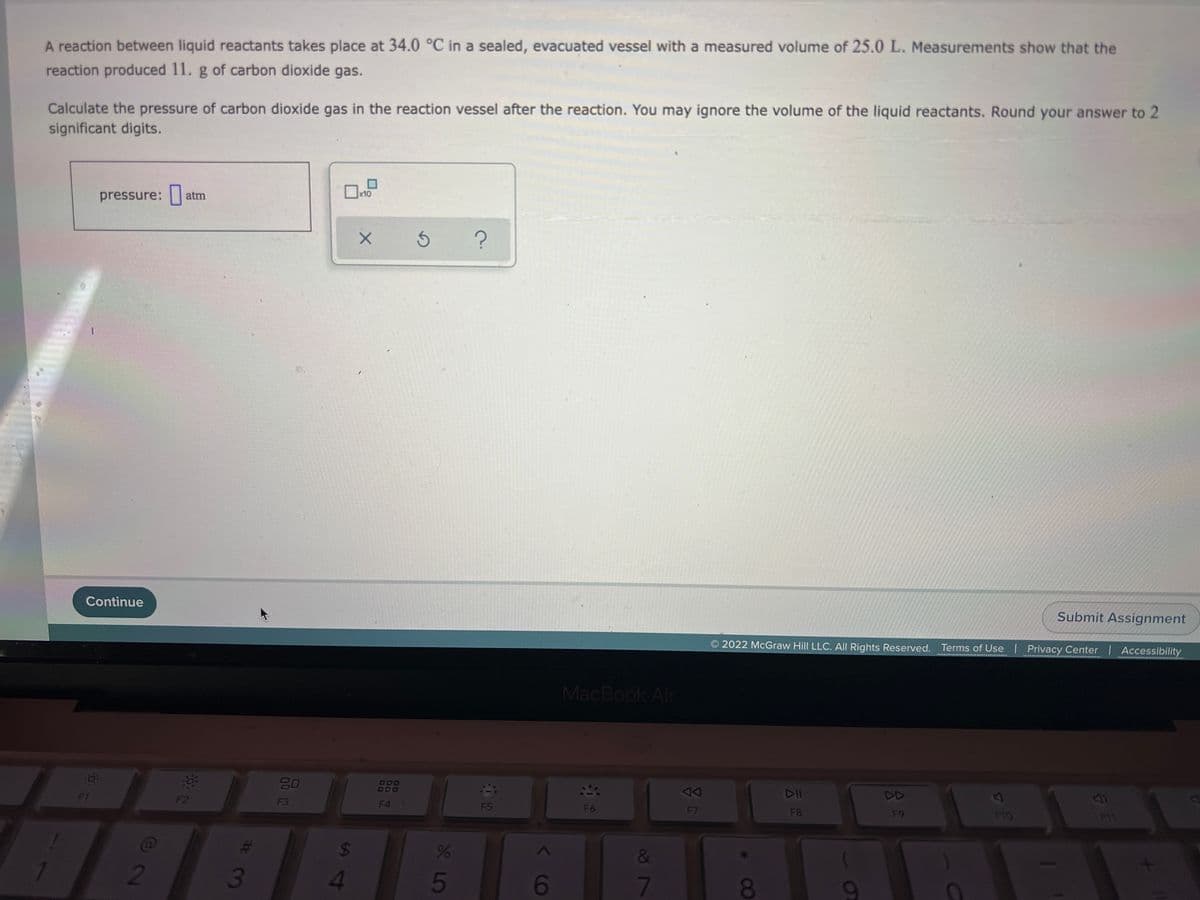A reaction between liquid reactants takes place at 34.0 °C in a sealed, evacuated vessel with a measured volume of 25.0 L. Measurements show that the reaction produced 11. g of carbon dioxide gas. Calculate the pressure of carbon dioxide gas in the reaction vessel after the reaction. You may ignore the volume of the liquid reactants. Round your answer to 2 significant digits. pressure: I atm
A reaction between liquid reactants takes place at 34.0 °C in a sealed, evacuated vessel with a measured volume of 25.0 L. Measurements show that the reaction produced 11. g of carbon dioxide gas. Calculate the pressure of carbon dioxide gas in the reaction vessel after the reaction. You may ignore the volume of the liquid reactants. Round your answer to 2 significant digits. pressure: I atm
Chemistry: Matter and Change
1st Edition
ISBN:9780078746376
Author:Dinah Zike, Laurel Dingrando, Nicholas Hainen, Cheryl Wistrom
Publisher:Dinah Zike, Laurel Dingrando, Nicholas Hainen, Cheryl Wistrom
Chapter13: Gases
Section: Chapter Questions
Problem 13STP
Related questions
Question

Transcribed Image Text:A reaction between liquid reactants takes place at 34.0 °C in a sealed, evacuated vessel with a measured volume of 25.0 L. Measurements show that the
reaction produced 11. g of carbon dioxide gas.
Calculate the pressure of carbon dioxide gas in the reaction vessel after the reaction. You may ignore the volume of the liquid reactants. Round your answer to 2
significant digits.
pressure: atm
x10
Continue
Submit Assignment
2022 McGraw Hill LLC. All Rights Reserved. Terms of Use | Privacy Center | Accessibility
MacBook Air
80
888
F1
F2
DD
F3
F4
F5
F6
F7
F8
F9
F10
11
&
2
6
7
8
8 L5
00
S14
73
Expert Solution
This question has been solved!
Explore an expertly crafted, step-by-step solution for a thorough understanding of key concepts.
This is a popular solution!
Trending now
This is a popular solution!
Step by step
Solved in 3 steps with 2 images

Knowledge Booster
Learn more about
Need a deep-dive on the concept behind this application? Look no further. Learn more about this topic, chemistry and related others by exploring similar questions and additional content below.Recommended textbooks for you

Chemistry: Matter and Change
Chemistry
ISBN:
9780078746376
Author:
Dinah Zike, Laurel Dingrando, Nicholas Hainen, Cheryl Wistrom
Publisher:
Glencoe/McGraw-Hill School Pub Co

Chemistry for Engineering Students
Chemistry
ISBN:
9781337398909
Author:
Lawrence S. Brown, Tom Holme
Publisher:
Cengage Learning

General Chemistry - Standalone book (MindTap Cour…
Chemistry
ISBN:
9781305580343
Author:
Steven D. Gammon, Ebbing, Darrell Ebbing, Steven D., Darrell; Gammon, Darrell Ebbing; Steven D. Gammon, Darrell D.; Gammon, Ebbing; Steven D. Gammon; Darrell
Publisher:
Cengage Learning

Chemistry: Matter and Change
Chemistry
ISBN:
9780078746376
Author:
Dinah Zike, Laurel Dingrando, Nicholas Hainen, Cheryl Wistrom
Publisher:
Glencoe/McGraw-Hill School Pub Co

Chemistry for Engineering Students
Chemistry
ISBN:
9781337398909
Author:
Lawrence S. Brown, Tom Holme
Publisher:
Cengage Learning

General Chemistry - Standalone book (MindTap Cour…
Chemistry
ISBN:
9781305580343
Author:
Steven D. Gammon, Ebbing, Darrell Ebbing, Steven D., Darrell; Gammon, Darrell Ebbing; Steven D. Gammon, Darrell D.; Gammon, Ebbing; Steven D. Gammon; Darrell
Publisher:
Cengage Learning

Chemistry: An Atoms First Approach
Chemistry
ISBN:
9781305079243
Author:
Steven S. Zumdahl, Susan A. Zumdahl
Publisher:
Cengage Learning


Chemistry
Chemistry
ISBN:
9781305957404
Author:
Steven S. Zumdahl, Susan A. Zumdahl, Donald J. DeCoste
Publisher:
Cengage Learning